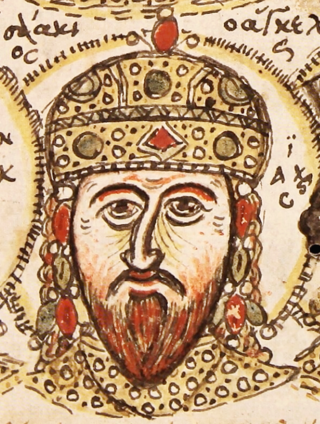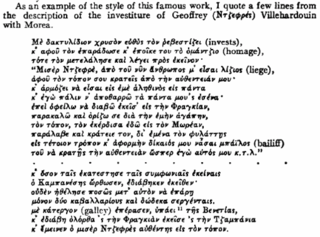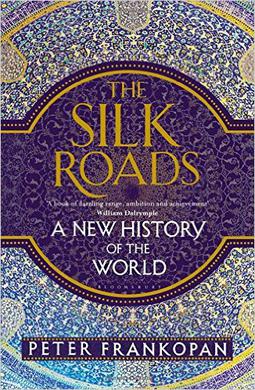
Constantinople became the capital of the Roman Empire during the reign of Constantine the Great in 330. Following the collapse of the Western Roman Empire in the late 5th century, Constantinople remained the capital of the Eastern Roman Empire, the Latin Empire (1204–1261), and the Ottoman Empire (1453–1922). Following the Turkish War of Independence, the Turkish capital then moved to Ankara. Officially renamed Istanbul in 1930, the city is today the largest city in Europe, straddling the Bosporus strait and lying in both Europe and Asia, and the financial centre of Turkey.

Year 1205 (MCCV) was a common year starting on Saturday of the Julian calendar.
Year 1183 (MCLXXXIII) was a common year starting on Saturday of the Julian calendar.

Isaac II Angelos or Angelus was Byzantine Emperor from 1185 to 1195, and co-Emperor with his son Alexios IV Angelos from 1203 to 1204. In a 1185 revolt against the Emperor Andronikos Komnenos, Isaac seized power and rose to the Byzantine throne establishing the Angelos family as the new imperial dynasty.

The First Crusade (1096–1099) was the first of a series of religious wars, or Crusades, initiated, supported and at times directed by the Latin Church in the medieval period. The objective was the recovery of the Holy Land from Islamic rule. While Jerusalem had been under Muslim rule for hundreds of years, by the 11th century the Seljuk takeover of the region threatened local Christian populations, pilgrimages from the West, and the Byzantine Empire itself. The earliest initiative for the First Crusade began in 1095 when Byzantine emperor Alexios I Komnenos requested military support from the Council of Piacenza in the empire's conflict with the Seljuk-led Turks. This was followed later in the year by the Council of Clermont, during which Pope Urban II supported the Byzantine request for military assistance and also urged faithful Christians to undertake an armed pilgrimage to Jerusalem.

The Fourth Crusade (1202–1204) was a Latin Christian armed expedition called by Pope Innocent III. The stated intent of the expedition was to recapture the Muslim-controlled city of Jerusalem, by first defeating the powerful Egyptian Ayyubid Sultanate. However, a sequence of economic and political events culminated in the Crusader army's 1202 siege of Zara and the 1204 sack of Constantinople, rather than the conquest of Egypt as originally planned. This led to the Partitio terrarum imperii Romaniae or the partition of the Byzantine Empire by the Crusaders and their Venetian allies leading to a period known as Frankokratia, or "Rule of the Franks" in Greek.
Anna Komnene, commonly Latinized as Anna Comnena, was a Byzantine Greek princess and historian. She is the author of the Alexiad, an account of the reign of her father, Byzantine emperor Alexios I Komnenos. Her work constitutes the most important primary source of Byzantine history of the late 11th and early 12th centuries, as well as of the early Crusades. Although she is best known as the author of the Alexiad, Anna played an important part in the politics of the time and attempted to depose her brother, John II Komnenos, as emperor in favour of her husband, Nikephoros.

The Alexiad is a medieval historical and biographical text written around the year 1148, by the Byzantine princess Anna Komnene, daughter of Emperor Alexios I Komnenos. It was written in a form of artificial Attic Greek. Anna described the political and military history of the Byzantine Empire during the reign of her father, thus providing a significant account on the Byzantium of the High Middle Ages. Among other topics, the Alexiad documents the Byzantine Empire's interaction with the Crusades and highlights the conflicting perceptions of the East and West in the early 12th century. It does not mention the schism of 1054 – a topic which is very common in contemporary writing. It documents firsthand the decline of Byzantine cultural influence in eastern and western Europe, particularly in the West's increasing involvement in its geographic sphere. The Alexiad was paraphrased in vernacular medieval Greek in mid-14th century to increase its readability, which testifies to the lasting interest in the work.
Tatikios or Taticius was an Eastern Roman general of Turkish origin during the reign of Alexius I Comnenus. His name is also rendered as Tetigus, Tatizius, Tatitius, Tatic, or Tetig.

The People's Crusade was the beginning phase of the First Crusade whose objective was to retake the Holy Land, and Jerusalem in particular, from Islamic rule. In 1095 the head of the Roman Catholic Church Pope Urban II started to urge faithful Christians to undertake an armed pilgrimage to Jerusalem, the People's Crusade was conducted for roughly six months from April to October 1096. It is also known as the Peasants' Crusade, Paupers' Crusade or the Popular Crusade as it was executed by a mainly untrained peasant army prior to the main church-organized crusade. It was led primarily by Peter the Hermit with forces of Walter Sans Avoir. The peasant army of this crusade was destroyed by the forces of the Seljuk Turks under Kilij Arslan at the Battle of Civetot in northwestern Anatolia.

The Chronicle of the Morea is a long 14th-century history text, of which four versions are extant: in French, Greek, Italian and Aragonese. More than 9,000 lines long, the Chronicle narrates events of the Franks' establishment of feudalism in mainland Greece. West European Crusaders settled in the Peloponnese following the Fourth Crusade. The period covered in the Chronicle was 1204 to 1292. It gives significant details on the civic organization of the Principality of Achaia.

Thomas Francis Madden is an American historian, a former chair of the history department at Saint Louis University in St. Louis, Missouri, and director of Saint Louis University's Center for Medieval and Renaissance Studies.

The Byzantine Empire, also referred to as the Eastern Roman Empire, was the continuation of the Roman Empire centered in Constantinople during Late Antiquity and the Middle Ages. The eastern half of the Empire survived the conditions that caused the fall of the West in the 5th century AD, and continued to exist until the fall of Constantinople to the Ottoman Empire in 1453. During most of its existence, the empire remained the most powerful economic, cultural, and military force in the Mediterranean world. The term "Byzantine Empire" was only coined following the empire's demise; its citizens referred to the polity as the "Roman Empire" and to themselves as "Romans". Due to the imperial seat's move from Rome to Byzantium, the adoption of state Christianity, and the predominance of Greek instead of Latin, modern historians continue to make a distinction between the earlier "Roman Empire" and the later "Byzantine Empire".

Samite was a luxurious and heavy silk fabric worn in the Middle Ages, of a twill-type weave, often including gold or silver thread. The word was derived from Old French samit, from medieval Latin samitum, examitum deriving from the Byzantine Greek ἑξάμιτον hexamiton "six threads", usually interpreted as indicating the use of six yarns in the warp. Samite is still used in ecclesiastical robes, vestments, ornamental fabrics, and interior decoration.

This history of the Byzantine Empire covers the history of the Eastern Roman Empire from late antiquity until the Fall of Constantinople in 1453 AD. Several events from the 4th to 6th centuries mark the transitional period during which the Roman Empire's east and west divided. In 285, the emperor Diocletian partitioned the Roman Empire's administration into eastern and western halves. Between 324 and 330, Constantine I transferred the main capital from Rome to Byzantium, later known as Constantinople and Nova Roma. Under Theodosius I, Christianity became the Empire's official state religion and others such as Roman polytheism were proscribed. Finally, under the reign of Heraclius, the Empire's military and administration were restructured and adopted Greek for official use instead of Latin. Although the Roman state continued, some historians choose to distinguish the Byzantine Empire from the earlier Roman Empire due to the imperial seat moving from Rome to Byzantium, the Empire’s integration of Christianity, and the predominance of Greek instead of Latin.
Nikephoros Diogenes, Latinized as Nicephorus Diogenes, was presumably a junior Byzantine emperor around 1069–1071. He was born c. 1069 to Emperor Romanos IV Diogenes and Empress Eudokia Makrembolitissa. He was elevated to junior emperor in 1070, although he lost this position when his father was overthrown in 1071. Emperor Alexios I Komnenos, after overthrowing Nikephoros III, made Nikephoros doux of Crete, and made him a general. Nikephoros conspired against him in 1094, involving numerous confidants and relatives of Alexios, including Alexios' brother, Adrianos. For this conspiracy, he was blinded, in accordance with Byzantine traditions. After this, he retired to his estates, and spent the last years of his life studying classical literature.

Byzantine silk is silk woven in the Byzantine Empire (Byzantium) from about the fourth century until the Fall of Constantinople in 1453.

The Silk Roads: A New History of the World is a 2015 non-fiction book written by English historian Peter Frankopan, a historian at the University of Oxford. A new abridged edition was illustrated by Neil Packer. The full text is divided into 25 chapters. The author combines the development of the world with the Silk Road.

The Darkening Age: The Christian Destruction of the Classical World is a 2017 book by Catherine Nixey. In the book, Nixey argues that early Christians deliberately destroyed classical Greek and Roman cultures and contributed to the loss of classical knowledge. The book was an international bestseller, was translated into 12 languages and was a New York Times Notable Book of 2018. The New York Times called it a “ballista-bolt of a book”. The book received positive reviews from academics such as Peter Frankopan, professor of Global History at Oxford University, Tim Whitmarsh, professor of Greek culture at Cambridge University, and others who praised its style and originality. It received criticism from some scholars of late antiquity and the Middle Ages, who accused it of telling a simplistic, polemical narrative and exaggerating the extent to which early Christians suppressed aspects of older Greek and Roman cultures.
The New Silk Roads: The Present and Future of The World is a 2018 non-fiction book by English historian Peter Frankopan. The full text is divided into 5 chapters. The author discusses the recent rise of Asia's economic and geopolitical strength.















